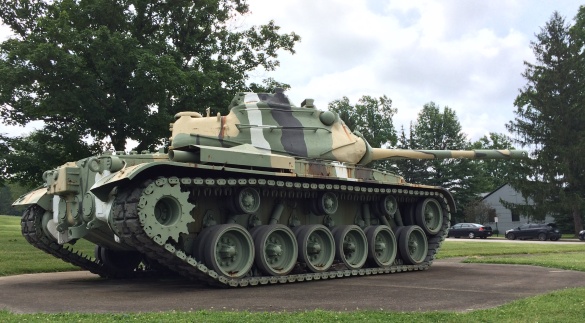Written By: Ted B Markley
Crane has a tank. It is a 1950’s era Patton (M47) Tank and dominates the well groomed grassy mall just north of the Administration building. Its presence at that location symbolizes many things.

In 1977 Naval Ammunition Depot Crane lost its Ordnance Department (Code 20) to the brand new Crane Army Ammunition Activity (CAAA). At the Department of Defense direction, Army became responsible for all conventional ammunition management. Suddenly ordnance workers who had been Navy employees all of their careers now worked for the United States Army. The transition had its moments. As one wag put it, “There are now four ways to do things, the right way, the wrong way, the Navy way and the Army way. Kind of a multiple choice approach to management!”
Change is frequently difficult, but the creation of the new Army Activity was successful and worked well. In the spirit of inter-service cooperation the commander of CAAA, LTC Arlee McCormick suggested to the commander of Crane Naval Weapons Support Center, CAPT Charles “Chuck” Johnson a symbol of Army’s presence at Crane should be added to the array of naval hardware. They agreed upon a tank. It may have been the last time there was mutual agreement on this subject.
Whether by intent or happenstance LTC McCormick selected an M47 Patton tank. It was perfect! It represented the transition of tank technology from the aftermath of World War II and the entrance into the Cold War.
Originally fielded in 1952, its main armament was a 90mm (M36) gun fitted with an M12 optical  rangefinder. Additional armaments consisted of a .30 caliber Browning machine gun mounted coaxially with the main gun and a bow machine gun (.30 caliber Browning). Finally, the ubiquitous M2 .50 caliber machine gun was mounted on the turret for anti-aircraft protection. Powered by a 12 cylinders, 820 HP, gasoline engine it had a range of about 80 miles at a top speed of 30 miles per hour. It was the very last U.S. tank with a five-man crew. It was not fitted with NBC protection, night vision, or computerized fire control systems.
rangefinder. Additional armaments consisted of a .30 caliber Browning machine gun mounted coaxially with the main gun and a bow machine gun (.30 caliber Browning). Finally, the ubiquitous M2 .50 caliber machine gun was mounted on the turret for anti-aircraft protection. Powered by a 12 cylinders, 820 HP, gasoline engine it had a range of about 80 miles at a top speed of 30 miles per hour. It was the very last U.S. tank with a five-man crew. It was not fitted with NBC protection, night vision, or computerized fire control systems.
The M47 did not see service in Korea. Due to its short range, it was not retained long by the U.S. Army. Most of the 8676 tanks produced were provided to NATO Allies for defense against the Red Threat in Europe.
The tank on display at Crane was used by the Italian Army for training purposes until the late 1980’s. The unusual camouflage scheme is a replication of the paint scheme that was on it when it arrived at Crane. It can only be assumed that this is perhaps an Italian camo pattern geared towards an Alpine environment. Crane’s tank represents both evolving tank technology and the complex geopolitical environment of the Cold War Era.
Eager to continue good relations Crane’s Executive Officer, CDR Ralph Darling, arranged for the renovation and placement of Crane’s newest military monument. Captain Johnson was on travel while the tank was being placed. When Captain Johnson returned to his office, he looked out of his window to see the 90mm main gun of an M47 Patton tank pointing directly at him. He got excited! Everyone he talked to got excited! He probably discussed the irreverence of the U.S. Army!

Shortly, CAPT Johnson and LTC McCormick had a meeting concerning the tank. No surviving notes were located from that meeting. Following that meeting, Public Works was back at the tank site. The Public Works staff manually rotated the main gun so it points away from Building One in a southwesterly direction (see picture). Following the realignment of the gun, the turret was welded in place so its position could not be altered.
So, Crane’s Tank represents a lot of things. Certainly it represents the vital presence and importance of CAAA, it represents the technology and geopolitical implications of the Cold War Era, and yes it represents some of the eruptions that provide those who work at Crane with a common history and a sense of community.
The dispute between Captain Johnson USN and LTC McCormick USA is the thing that urban legends are made of. There is little doubt that it has grown with the telling. But, as Winston Churchill said when being challenged for including King Arthur in his multi-volume History of the English Speaking People, “If it is not true, it should be!!!
Sources:
Jane’s Tanks and Combat Vehicles Recognition Guide, Christopher F. Foss. Harper Collins Publishers, NY. 2000.
Battle Tanks http://www.battletanks.com/
Patton Mania http://www.patton-mania.com/M47_Patton/m47_patton.html
American Armoured Foundation Tank Museum http://www.aaftankmuseum.com/
Numerous interviews

Enjoy these stories of our historical markers. Seen them my entire career, and never knew the backstory of most of them. Thanks for the informative and entertaining articles!
LikeLike
Thank you for the kind feedback Susie!
LikeLike